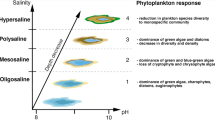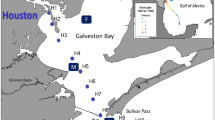Abstract
At low trophic state, stable stratified water columns may provide favorable conditions for adapted phytoplankton species to form deep chlorophyll maxima (DCM). Such maxima occur regularly in Lake Stechlin, mainly contributed by the cyanobacterial species Cyanobium sp. and occasionally by Planktothrix rubescens. In the early twenty-first century, a rapid invasion by nostocalean cyanobacteria occurred in the lake and a number of Dolichospermum species together with Aphanizomenon flos-aquae appeared. As revealed by both microscopic and fluorimetric methods, during the summer stratification of 2013, a multispecific DCM was formed by Cyanobium, Planktothrix rubescens, and A. flos-aquae, however with spatial segregation. Planktothrix occurred in the upper hypolimnion, Aphanizomenon and Cyanobium dominated in the metalimnetic layer. Coexistence of these three cyanoprokaryota is possibly the consequence of different environmental factors limiting them (light, availability of N and P). This study represents a rare case when spatial niche segregation of phytoplankton species occurs in close to equilibrium conditions. DCM formed by Aphanizomenon and Cyanobium was detected by the fluoroprobe; Planktothrix with its different pigment compositions remained largely hidden. Our results indicate the necessity of parallel microscopic investigations and the need of careful calibration when fluorimetric methods are used for detecting cyanobacterial populations.








Similar content being viewed by others
References
Abbott, M. R., K. L. Denmann, T. M. Powell, P. J. Richerson, R. C. Richards & C. R. Goldman, 1984. Mixing and the dynamics of a deep chlorophyll maximum in Lake Tahoe. Limnology and Oceanography 29: 862–878.
Akçalaan, R., L. Köker, C. Gürevit & M. Albay, 2014. Planktothrix rubescens: a perennial presence and toxicity in Lake Sapanca. Turkish Journal of Botany 38: 782–794.
APHA—American Public Health Association, 1998. Standard Methods for the Examination of Water and Wastewater, 20th ed. United Book Press Inc, Baltimore, MD.
Barbiero, R. P. & J. Kann, 1994. The importance of benthic recruitment to the population development of Aphanizomenon flos-aquae and internal loading in a shallow lake. Journal of Plankton Research 16: 1581–1588.
Barbiero, R. P. & M. L. Tuchman, 2001. Results from the US EPA’s biological open water surveillance program of the Laurentian Great Lakes: II. Deep chlorophyll maxima. Journal of Great Lakes Research 27: 155–166.
Barbiero, R. P. & M. L. Tuchman, 2004. The deep chlorophyll maximum in Lake Superior. Journal of Great Lakes Research 30: 256–268.
Bauchrowitz, M., 2012. The LakeLab—a new experimental platform to study impacts of global climate change on lakes. SILnews 60(June): 10–12.
Bird, D. F. & J. Kalff, 1989. Phagotrophic sustenance of a metalimnetic phytoplankton peak. Limnology and Oceanography 34: 155–162.
Borics, G., A. Abonyi, E. Krasznai, G. Várbíró, I. Grigorszky, S. Szabó, Cs Deák & B. Tóthmérész, 2011. Small-scale patchiness of the phytoplankton in a lentic oxbow. Journal of Plankton Research 33: 973–981.
Bright, D. I. & A. E. Walsby, 2000. The daily integral of growth by Planktothrix rubescens calculated from growth rate in culture and irradiance in Lake Zurich. New Phytologist 146: 301–316.
Callieri, C., 2008. Picophytoplankton in freshwater ecosystems: The importance of small-sized phototrophs. Freshwater Reviews 1: 1–28.
Camacho, A., 2006. On the occurrence and ecological features of deep chlorophyll maxima (DCM) in Spanish stratified lakes. Limnetica 25: 453–478.
Casper, S. J. (ed.), 1985. Lake Stechlin. A Temperate Oligotrophic Lake. Dr. W. Junk Publ, Dordrecht.
Clegg, M. R., U. Gaedke, B. Boeher & E. Spijkerman, 2012. Complementary ecophysiological strategies combine to facilitate survival in the hostile conditions of a deep chlorophyll maximum. Oecologia 169: 609–622.
Davis, P. A., M. Dent, J. Parker, C. S. Reynolds & A. E. Walsby, 2003. The annual cycle of growth rate and biomass change in Planktothrix spp. in Blelhalm tarn, English lake district. Freshwater Biology 48: 852–867.
Dokulil, M. T. & K. Teubner, 2012. Deep living Planktothrix rubescens modulated by environmental constraints and climate forcing. Hydrobiologia 698: 29–46.
Fahnenstiel, G. L. & J. M. Glime, 1983. Subsurface chlorophyll maximum and associated Cyclotella pulse in Lake Superior. Internationale Revue der gesamten Hydrobiologie 68: 605–616.
Gervais, F., 1997. Diel vertical migration of Cryptomonas and Chromatium in the deep chlorophyll maximum of a eutrophic lake. Journal of Plankton Research 19: 533–550.
Gervais, F., J. Padisák & R. Koschel, 1997. Do light quality and low phosphorus concentration favour picocyanobacteria below the thermocline of the oligotrophic Lake Stechlin? Journal of Plankton Research 19: 771–781.
Gorzó, G., 1987. Fizikai és kémiai faktorok hatása a Balatonban előforduló heterocisztás cianobaktériumok spóráinak csírázására (The influence of physical and chemical factors on the germination of spores of heterocystic cyanobacteria in Lake Balaton). Hidrológiai Közlöny 67: 127–133. (in Hungarian with English summary).
Grigorszky, I., J. Padisák, G. Borics, C. Schitchen & G. Borbély, 2003. Deep chlorophyll maximum by Ceratium hirundinella (O.F. Müller) Berg in a shallow oxbow in Hungary. Hydrobiologia 506–509: 209–212.
Halstvedt, C. B., T. Rohrlack, T. Andersen, O. Skulberg & B. Edvardsen, 2007. Seasonal dynamics and depth distribution of Planktothrix spp. in Lake Steinsfjorden (Norway) related to environmental factors. Journal of Plankton Research 29: 471–482.
Hardin, G., 1960. The competitive exclusion theory. Science 131: 1292–1297.
Hingsamer, P., F. Peeters & H. Hofmann, 2014. The consequences of internal waves for phytoplankton focusing on the distribution and production of Planktothrix rubescens. PloS one 9(8): e104359.
Holm-Hansen, O. & C. D. Hewes, 2004. Deep chlorophyll a maxima (DCMs) in Antarctic waters. Polar Biology 27: 699–710.
Juday, C., 1934. The depth distribution of some aquatic plants. Ecology 15: 325.
Karlsson-Elfgren, I. & A. K. Brunberg, 2004. The importance of shallow sediments in the recruitment of Anabaena and Aphanizomenon (Cyanophyceae). Journal of Phycology 40: 831–836.
Koenings, J. P. & J. A. Edmundson, 1991. Secchi disk and photometer estimates of light regimes in Alaskan lakes: effects of yellow color and turbidity. Limnology and Oceanography 36: 91–105.
Konopka, A., 1982. Physiological ecology of a metalimnetic Oscillatoria rubescens population. Limnology and Oceanography 27: 1154–1161.
Konopka, A., 1989. Metalimnetic cyanobacteria in hard-water lakes: Buoyancy regulation and physiological state. Limnology and Oceanography 34: 1174–1184.
Körner, C., 1993. Scaling from species to vegetation: The usefulness of functional groups. In Schulze, E. D. & H. A. Mooney (eds), Biodiversity and Ecosystem Function. Ecological Studies. Springer, Berlin: 117–140.
Krieger, W., 1927. Die Gattung Centronella Voigt.—Ber Deutsch. Botanischen Gesellschaft 45: 281–290.
Larson, D. W., C. N. Dahm & N. S. Geiger, 1987. Vertical partitioning of the phytoplankton assemblage in the ultraoligotrophic Crater Lake, Oregon, U.S.A. Freshwater Biology 18: 429–442.
Leboulanger, C., U. Dorigo, S. Jacquet, B. Le Berre, G. Paolini & J. F. Humbert, 2002. Application of a submersible spectrofluorometer for rapid monitoring of freshwater cyanobacterial blooms: a case study. Aquatic Microbial Ecology 30: 83–89.
Lund, J. W. G., C. Kipling & E. D. LeCren, 1958. The invert microscope method of estimating algal numbers and the statistical basis of estimations by counting. Hydrobiologia 11: 143–170.
Micheletti, S., F. Schanz & A. E. Walsby, 1998. The daily integral of photosynthesis by Planktothrix rubsecens during summer stratification and autumnal mixing in Lake Zürich. New Phytologist 139: 233–246.
Naselli-Flores, L., J. Padisák, M. T. Dokulil & I. Chorus, 2003. Equilibrium/steady-state concept in phytoplankton ecology. Hydrobiologia 502: 395–403.
OPTICOUNT, 2008. http://science.do-mix.de/software_opticount.php.
Padisák, J., L. Krienitz, R. Koschel & J. Nedoma, 1997. Deep layer autotrophic picoplankton maximum in the oligotrophic Lake Stechlin, Germany: origin, activity, development and erosion. European Journal of Phycology 32: 403–416.
Padisák, J., F. A. R. Barbosa, R. Koschel & L. Krienitz, 2003a. Deep layer cyanoprokaryota maxima are constitutional features of lakes: examples from temperate and tropical regions. Archiv für Hydrobiologie, Special Issues, Advances in Limnology 58: 175–199.
Padisák, J., W. Scheffler, P. Kasprzak, R. Koschel & L. Krienitz, 2003b. Interannual changes (1994–2000) of phytoplankton of Lake Stechlin. Archiv für Hydrobiologie, Special Issues, Advances in Limnology 58: 101–133.
Padisák, J., É. Hajnal, L. Krienitz, J. Lakner & V. Üveges, 2010. Rarity, ecological memory, rate of floral change in phytoplankton—and the mystery of the Red Cock. Hydrobiologia 653: 45–64.
Pełechaty, M. & P. M. Owsianny, 2003. Horizontal distribution of phytoplankton as related to the spatial heterogeneity of a lake—a case study from two lakes of the Wielkopolski National Park (western Poland). Hydrobiologia 510: 195–205.
Queimaliños, C. P., B. E. Modunetti & E. G. Balseiro, 1999. Symbiotic association of the ciliate Ophrydium naumanni with Chlorella causing a deep chlorophyll a maximum in an oligotrophic South Andes lake. Journal of Plankton Research 21: 167–178.
Reynolds, C. S., 2006. Ecology of Phytoplankton. Cambridge University Press, Cambridge.
Salmaso, N., D. Copetti, L. Cerasino, S. Shams, C. Capelli, A. Boscaini, F. Pozzoni & L. Guzzella, 2014. Variability of microcystin cell quota in metapopulations of Planktothrix rubescens: Causes and implications for water management. Toxicon 90: 82–96.
Salmaso, N., L. Naselli-Flores & J. Padisák, 2015. Functional classifications and their application in phytoplankton ecology. Freshwater Biology 60: 603–619.
Solis, M. & W. Wojciechowska, 2014. Vertical distribution of phytoplankton in two mesotrophic lakes Annales University Maria Curie-Sklodowska. Biologia 68: 73–82.
Tapolczai, K., V. Üveges, G. B. Selmeczy, P. Casper, L. Krienitz & J. Padisák, 2013. Az Aphanizomenon flos-aquae vertikális eloszlása egy mély, oligo-mezotróf tóban. Hidrológiai Közlöny 93(5-6): 75–77.
Teubner, K., R. Feyerabend, M. Henning, A. Nicklisch, P. Woitke & J.-G. Kohl, 1999. Alternative blooming of Aphanizomenon flos-aquae or Planktothrix agardhii induced by the timing of the critical nitrogen:phosphorus ratio in hypertrophic riverine lakes. Archiv für Hydrobiologie Special Issues Advances in Limnology 54: 325–344.
Üveges, V., K. Tapolczai, L. Krienitz & J. Padisák, 2012. Photosynthetic characteristics and physiological plasticity of an Aphanizomenon flos-aquae (Cyanobacteria, Nostocaceae) winter bloom in a deep oligo-mesotrophic lake (Lake Stechlin, Germany). Hydrobiologia 698: 263–272.
Vasas, G., O. Farkas, G. Borics, T. Felföldi, G. Sramkó, G. Batta, I. Bácsi & S. Gonda, 2013. Appearance of Planktothrix rubescens bloom with [D-Asp3, Mdha7]MC-RR in gravel pit pond of a shallow lake-dominated area. Toxins 5: 2434–2455.
Welch, E. B., 1992. Ecological Effects of Waste Water. Chapman & Hall, London. 455 pp.
Wildman, R. B., J. H. Loescher & C. L. Winger, 1975. Development and germination of akinetes of Aphanizomenon flos-aquae. Journal of Phycology 11: 96–104.
Yamamoto, Y., 2009. Environmental factors that determine the occurrence and seasonal dynamics of Aphanizomenon flos-aquae. Journal of Limnology 68: 122–132.
Yamamoto, Y. & H. Nakahara, 2009. Life cycle of Cyanobacterium Aphanizomenon flos-aquae. Taiwania 54: 113–117.
Acknowledgements
We thank Mr. Michael Sachtleben, Ms. Maren Lentz, Ms. Uta Mallok, and Ms. Monika Papke for their field and laboratory assistance. The project “TemBi—Climate driven changes in biodiversity of microbiota” is granted by the Leibniz society (SAW-2011-IGB-2).
Author information
Authors and Affiliations
Corresponding author
Additional information
Guest editors: Luigi Naselli-Flores & Judit Padisák / Biogeography and Spatial Patterns of Biodiversity of Freshwater Phytoplankton
Rights and permissions
About this article
Cite this article
Selmeczy, G.B., Tapolczai, K., Casper, P. et al. Spatial- and niche segregation of DCM-forming cyanobacteria in Lake Stechlin (Germany). Hydrobiologia 764, 229–240 (2016). https://doi.org/10.1007/s10750-015-2282-5
Received:
Revised:
Accepted:
Published:
Issue Date:
DOI: https://doi.org/10.1007/s10750-015-2282-5




